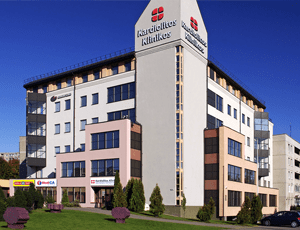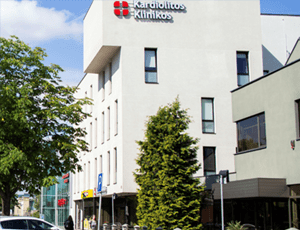Treatment cost

Kardiolita Hospital, Vilnius located in Vilnius, Lithuania is accredited by JCI. Also listed below are some of the most prominent infrastructural details:


Apart from in-detail treatment procedures available, Kardiolita Hospital, Kaunas located in Kaunas, Lithuania has a wide variety of facilities available for International Patients. Some of the facilities which are provided by them are Accommodation, Airport Transfer, Choice of Meals. Also listed below are some of the most prominent infrastructural details:
This procedure, known as Transurethral Resection of Bladder Tumor (TURBT), is designed to detect and remove bladder tumors in their early stages by inserting a scope through the urethra leading to the bladder. During the TURBT procedure, urologists can identify bladder cancer and potentially address various other bladder-related disorders. It's noteworthy that around 75% of detected bladder cancers are superficial, meaning they only grow on the surface of the bladder walls without penetrating deeply. This characteristic allows surgeons to remove the tumor at the bladder wall level without causing damage to the deeper layers of the organ. The information gathered during the procedure assists surgeons in determining the type and extent of the tumor's abnormality. This information is crucial as it helps urologist surgeons decide whether further treatments are necessary.
The bladder, a sac-like muscular organ, resides in the pelvic region above the pelvic bone. It connects to the kidneys via two ureters, which transport urine from the kidneys to the bladder for storage. Abnormal cell growth in the inner lining can lead to the development of a tumor, necessitating diagnosis followed by TURBT surgery.
In the initial stages, tumors are often difficult to detect. Patients may exhibit few notable symptoms when harboring a primary tumor.
Progressing through stages of bladder cancer, Stage 0, also known as carcinoma in situ, represents non-invasive papillary cancer. At Stage I, cancer affects the bladder's lining but has not invaded the muscular wall. Stage II marks invasion into the bladder's muscles, rendering it invasive. Stage III denotes further spread into nearby tissues like reproductive organs. Finally, Stage IV indicates lymph node involvement and spread to surrounding organs.
The causes of tumors in the bladder are not clear and well defined but it has been linked to smoking, chemical exposure to radiation, or a parasitic infection. The abnormal cells undergo some mutation that allows them to multiply in a nonorderly fashion and goes beyond control and they do not die thus giving rise to the tumor.
A person suffering from a tumor will experience mild sensations of burning and discomfort in the times of urination for quite a few days. The force of the urinary stream may also undergo significant changes which can be observed for a week to a fortnight. Usually, there could be none of the symptoms and in certain cases, all symptoms even if experienced may not lead to the conclusion that it is a bladder cancer. There can be blood or clots of blood in the urine along with a tendency to urinate too frequently. The tendency of urinating at night may be felt more but there can be general problems in urine passing. Associated along with this the patient can experience pain on either side of the body.
Some of the other treatment alternatives for TURBT are being worked upon while some of them have tremendous side effects
Blue light fluorescent cystoscopy : Enhanced tumour visualization is possible and detection of tumour chances are increased by almost 20 to 25% with this method where an ultraviolet blue light is used. A dye is injected an hour prior to the procedure.
Adjuvant bladder cancer therapy: TURBT is not suitable for many who have a high chance of suffering a recurrence within 12 months from the treatment. In this case adjuvant therapy is recommended. It includes intravesicle chemotherapy. Chemotherapy for bladder cancer includes giving medication to curb the abnormal growth of cells. But it also has its sets of side effects like experiencing irritation in the bladder and loss of hair, nails and feeling debilitated for a very long period of time.
A catheter will be given to the patient while going home and nurses will instruct how to maintain it clean and use it as a drainage bag. How to remove the catheter will also be taught which is a very simple and easy step and has very little discomfort associated with it. Antibiotics can be used in the form of ointment around the tip of the catheter to reduce irritation. Usage of an overnight bag is very convenient since it can store the urine for a longer period of time. It happens that there may be some blood clots that may pass while urinating; this must not scare you as it is normal. In addition to the overnight bag while walking a leg bag can also be worn. But if you find persistent clotting and large clots or the catheter is found not draining urine anymore you should inform your surgeon.
The total period of recovery is pretty long as 6 weeks and can be divided into two weeks and then the last 4 weeks. During the first 2 weeks the patient is expected to behave as leisurely as possible and do very light activities and sexual activity must be avoided during this period. Of course, within the first week, one should go and collect the biopsy report and adhere to the medications prescribed by the doctor. In the next 4 weeks, the patient can slowly resume back normal activities with periodic checkups with the doctor to understand the health and chances of recurrence.
Ask your healthcare adviser for the best multiple options and choose the one that meets your expectations
The cost of Trans Urethral Resection of Bladder Tumor (TURBT) in Vilnius may differ from one medical facility to the other. The top hospitals for Trans Urethral Resection of Bladder Tumor (TURBT) in Vilnius covers all the expenses related to the pre-surgery investigations of the candidate. Typically, the package cost of Trans Urethral Resection of Bladder Tumor (TURBT) in Vilnius includes the expenses related to the surgeon's fee, anesthesia, hospital, meals, nursing and ICU stay. Post-surgical complications, new findings and delayed recovery may have an impact on the total Trans Urethral Resection of Bladder Tumor (TURBT) cost in Vilnius.
There are several best hospitals for Trans Urethral Resection of Bladder Tumor (TURBT) in Vilnius. Some of the best hospitals for Trans Urethral Resection of Bladder Tumor (TURBT) in Vilniusinclude the following:
After Trans Urethral Resection of Bladder Tumor (TURBT) in Vilnius, the patient is supposed to stay in guest house for another 12 days. This period is important to conduct all the follow-up tests to ensure that the surgery was successful and the patient can go back to the home country.
One of the topmost destinations for Trans Urethral Resection of Bladder Tumor (TURBT) is Vilnius. It has a variety of accredited hospital, affordable cost of treatment and some of the best medical fraternity. Some of the other top destinations for Trans Urethral Resection of Bladder Tumor (TURBT) include the following:
There are certain additional cost that the patient has to pay apart from the Trans Urethral Resection of Bladder Tumor (TURBT) cost. These include the cost of accommodation and meals outside hospital. The per day cost in this case may range from 50 USD.
The patient has to spend about 2 Days in the hospital after Trans Urethral Resection of Bladder Tumor (TURBT) for proper recovery and to get clearance for discharge. The doctors team review the patient's recovery during this time with the help of blood tests and imaging scans. Once they feel that everything is on track, the patient is discharged.
Out of all the hospitals in Vilnius, there are about 1 Hospitals best hospitals for Trans Urethral Resection of Bladder Tumor (TURBT) in Vilnius. These hospitals have propoer infrastructure as well as offer good quality of services when it comes to Trans Urethral Resection of Bladder Tumor (TURBT) surgery. Also, these hospitals follow the necessary guidelines as required by the medical associations for the treatment of Trans Urethral Resection of Bladder Tumor (TURBT) patients.
Some of the most sought after doctors for Trans Urethral Resection of Bladder Tumor (TURBT) in Vilnius are: